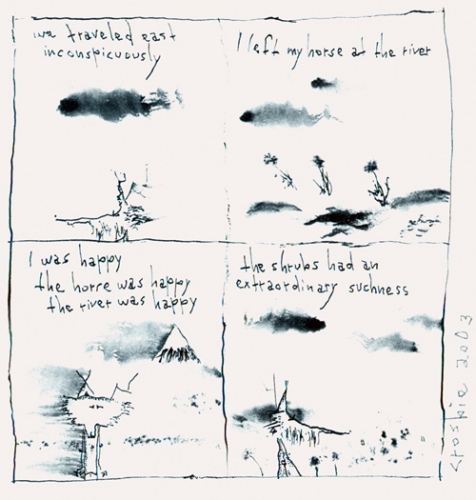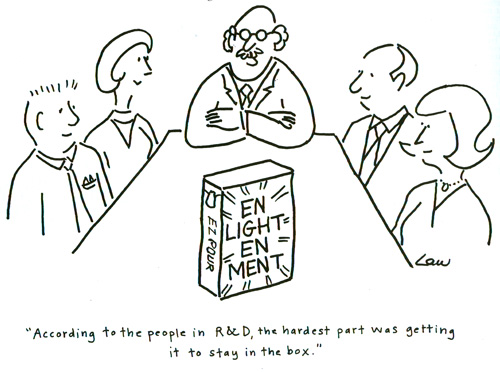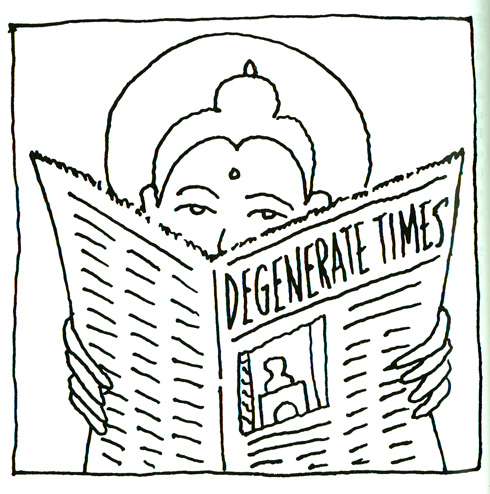Chant or Cant?
As a practitioner of Nichiren Buddhism with the Soka Gakkai, I have certainly come across articles and other writings on our organization. (I used to marvel at the fact that the SGI was rarely, if ever, mentioned in Tricycle and other Buddhist publications, considering its membership size and scope.) As Clark Strand points out in his article “Born in the USA: Racial Diversity in Soka Gakkai International” [Winter 2003], these publications have often maligned SGI. Strand has made an excellent and noteworthy effort in addressing this large oversight. Not only did I find Strand’s writing to be clear and engaging, but his exploration of race within Buddhism, and particularly in the SGI, was rich and informed.
When I first encountered SGI over four years ago, I too was struck by the diversity of its membership and the incredibly empowering philosophy of Nichiren Daishonin and the founding three presidents of the Soka Gakkai (Tsunesaburo Makiguchi, Josei Toda, and Daisaku Ikeda). And I still never cease to be awed by the incredible hard work, dedication, and sacrifice each (as well as other pioneering members and leaders like Ronnie Smith) has made, particularly in shaping the organization into a place for all people.
Strand’s article has brought to the fore the pressing and pertinent issues of diversity and racism within the American Buddhist movement, and, in my opinion, has justly conveyed the spirit of our organization toward addressing these and other realities of the American—and human—experience.
—Jonathan Brody, Northampton, Massachusetts
I read Clark Strand’s article “Born in the USA” with considerable interest and some perplexity. To explain SGI’s racial diversity, Mr. Strand proposes that “when African Americans step into a Buddhist meditation center, [the] invisible [white] culture is the first thing they see.” Mr. Strand fails to mention the fact that SGI is the only Buddhist organization in America that actively proselytizes. Although the aggressive street recruiting of the oldshakubuku [literally, “propagation”] days may be a thing of the past, Soka Gakkai members are encouraged to evangelize their friends, relatives, neighbors, coworkers, and schoolmates and bring them into the fold. Left to their own devices, would African and Hispanic Americans seek out Soka Gakkai any more than they do Zen or Tibetan Buddhism? Or is SGI’s diversity more likely a reflection of its emphasis on recruitment than it is the response to a racist miasma, invisible to European and Asian Americans but perceptible to African and Hispanic Americans, which secretly infects all varieties of Buddhism save Soka Gakkai? As the Buddha told the Kalamas, “If it agrees with observation and reason, then believe it.”
—Ralph Doty, E-mail
The article on Soka Gakkai’s ethnic diversity was informative, but the author’s suggestion that Buddhist organizations that are predominantly “white” do not welcome “nonwhites” is weak. Further, it makes no sense to make vague assumptions about the ethnic demographics of various Buddhist groups without bringing real percentage figures into the greater context of historical development.
Non-Asian Buddhists in the United States are mainly converts. Thus, the current ethnic blend of any particular Buddhist group reflects the history of that group’s previous outreach efforts, and may not reflect the attitudes of its present membership or its tenets.
The author cites the active proselytizing by Soka Gakkai members and estimates that roughly 20 percent of SGI members are African American (the African American U.S. population is about 14 percent). To determine whether SGI is inherently more ethnically diverse, as the article implies, or consequentially so, one would have to determine whether Soka Gakkai engaged in conversion activities in similar proportion to the racial diversity of the U.S. population. If it did, one would have to ascertain whether it did so as aggressively in predominantly white communities as it did in the inner city.
It seems that the author is looking not really for dharma per se, but for a culturally diverse group of friends who happen to share an interest in some type of Buddhism. Fellowship is an important function of any church. But when one is meditating (or chanting) with eyes closed or gazing at the floor, all Buddhist centers seem to look pretty much alike.
—Paul Volker, E-mail
Clark Strand Responds
Although it is not entirely true that SGI is “the only Buddhist organization in America that actively proselytizes” (a quick perusal of the advertisements in this magazines will reveal advertisers whose purpose is clearly to win converts—dare I say customers—to its particular form of Buddhism), it is nevertheless true that SGI’s method of recruitment has had much to do with its success in attracting diversity. It is, however, patently untrue that SGI has recruited African Americans more aggressively than white Americans. That it has tried to recruit them at all makes SGI utterly unique in American Buddhism, and this fact, more than any other, led me to investigate why that might be so.
Racial inequity is as much the historic legacy of our country as our Constitution. In psychological terms, it reveals the shadow side of American society, the part we would rather not look at too closely, the part we would rather not see. It is interesting to me that at the end of his letter Mr. Volker writes, “[W]hen one is meditating (or chanting) with eyes closed or gazing at the floor, all Buddhist centers seem to look pretty much alike.” I would simply challenge him to look up for once in his particular Buddhist center and count how many faces of color he sees.

Touché, Soulé (And a Little Praise, Too)
Regarding the profile of “eco-warrior” Michael Soulé [“Buckshot Bodhisattva,” Winter 2003]: perhaps the most ecologically friendly thing for me to do would be to kill and eat suburban dwellers to reduce my footprint on the earth and control urban sprawl. That doesn’t mean that it’s the right thing to do.
—Pablo Miramontes, Victoria, British Columbia
I was appalled and deeply saddened to read that Michael Soulé considers himself a dharma practitioner while continuing to hunt and harm defenseless animals. Being a true dharma practitioner means giving up acts that are harmful—verbal, mental, and behavioral—and not conveniently rationalizing why one has to continue these harmful acts. Instead of hunting deer, Dr. Soulé can always write and engage in other nonharmful acts in order to advocate for the preservation of biological diversity. If he finds it necessary to continue to kill in order to enhance biodiversity, he is pursuing a wrong livelihood.
—Reiko Makiuchi – New York, New York
Your fiftieth issue was the best ever. But I do have a quibble with the story on Michael Soulé. It seems to me that killing nature’s creatures for pleasure is best left to non-Buddhists. Mr Soulé’s argument—that putting a dent in the herbivore overpopulation is not a bad thing—is a pretty weak position to take. In this day and age, deer populations across the country are managed as a crop to be “harvested” by hunters. If there are too many deer, the various state departments of wildlife and fisheries extend the hunting season. If there are too few, predator hunting is opened up.
I assume that the Buddhist outlook on permitted “surgical violence” would imply an ultimate good to be derived from the action. Shooting deer implies no such good. It is really not much different than shooting a cow in the field, or for that matter going to a game farm where, as in this state at least, game animals are raised for the specific “sport” of “animal killing.”
I do greatly admire Michael Soulé and his work, but in this instance I think he is wrong!
—Marcel Rodriguez, Springdale, Utah
Finally! A scientist’s voice is heard in Tricycle and there’s no mumbojumbo about the Big Bang, or parallel quantum universes, or how Buddhism is a science. Instead, there are words that resonate with actual experience. In her profile of Michael Soulé, Lisa Jones writes:
“Scientists interact by sparring intellectually. ‘They’re trained to criticize, to find the flaw in the argument,’ [Soulé] said. ‘That puts you in a reactive, hostile state of mind.’ It’s just what he’s working to undo.”
There is tension between science and Buddhism. It would be good to hear more about it.
—Brad Marston, Professor of Physics, Brown University, Providence, Rhode Island
Michael Soulé Responds
The issue is what, where, and how to kill, not whether. The American Buddhist vegan indirectly kills many deer, mice, reptiles, and hundreds of other species of animals by co-opting their habitat for farming, houses, stores, hospitals, roads, airports, and dharma centers. Moreover, few of us calculate the cost in animal lives of hauling food in trucks (road kills) and of feeding pets their meat-based foods.
Or consider tofu. In the U.S., the consumption of soy products would not be economical were it not for deer hunters. This is because crop depredation by deer on soy beans is so serious a problem in the Midwest that farmers would go belly-up in many places within three to five years if hunting were outlawed. In an ecologically ideal world, predators would keep the deer in check, and state game agencies would be perfect managers of wildlife. Simple greed precludes both from happening.
The letter writers who abhor hunting mammals certainly have a conscionable case. I would simply ask, Which policy does the least harm to nature: ethical hunting of super-abundant animals, or allowing human-caused ecological disharmonies to degrade the earth? Ethical paralysis and denial in the face of such dilemmas are forms of ignorance (one of the Three Poisons), as would be my claim that my way is the most ethical course for everyone.

Separation Anxiety?
In response to the question of whether mindfulness is a religion [“Events,” Winter 2003] and, therefore whether Thich Nhat Hanh’s retreat for police officers and other civil servants violated the separation of church and state, I would start by pointing out that mindfulness is a spiritual practice, not a religion. Like most spiritual practices, however, it is inextricably intertwined with a religious tradition, in this case that of Vietnamese Zen Buddhism.
With all due respect to Thich Nhat Hanh (in whose tradition I practice) and his attempts to promote nonsectarian spiritual practice, I am wary of disconnecting spiritual practices from religious teachings. I fear that this could leave the practices watered down, as has happened to yoga, or practitioners without intellectual guidance when they hit a crisis in their practice. But I do not think this close link between mindfulness and Zen means that the retreat violated the separation of church and state—I think both the author, Mark Phillips, and Americans United for Separation Between Church and State misunderstand the original purpose of this separation, imagining it means that religion should have no role in public life.
The original intention behind the separation of church and state was not to exclude religion from public life but to keep the state from setting up one religion above all others—thus protecting both democracy and the independence, and therefore integrity, of all religious traditions. In this way, multiple religions can (and should) play an important role in public life, offering their wisdom in the difficult task of creating a more compassionate and just social order. I think Thich Nhat Hanh has something valuable to offer many police officers, tools that will allow them to do their work in a more compassionate, less destructive way. But other religions have equally valuable tools. Indeed, for many people, spiritual practices linked with other traditions, such as Christian contemplative prayer or Wiccan ritual, may be better suited to their temperament. I would say we need more retreats such as this, drawing on more traditions; by involving a multiplicity of religious traditions in public life, we can best support both the separation of church and state and a more compassionate, just society.
—Matthew Williams, Boston, Massachusetts
That’s A Lot of Borscht!
I was disappointed by “Borscht Belt Buddhism” in your 50th anniversary issue. As a longtime resident of the Catskill Mountains, and as a longtime reader of Tricycle—since your first issue, in the fall of 1991—I am disappointed that you allowed the inaccurate use of the term “Borscht Belt” to describe the location of the six Zen centers! The author used the phrase as a general description for all of the Catskills, which it is not. “Borscht Belt” was derived from the venues for Yiddish humor at the summer resorts in Sullivan County in the southwestern Catskill Mountains. These famous hotels gave comedians like Jerry Lewis and Buddy Hackett their start. In fact, in books and online materials, the area is commonly referred to as “Sullivan County’s Borscht Belt.”
Only one of the dharma centers mentioned in the piece is actually in the Borscht Belt—Dai Bosatsu Zendo Kongo-Ji, in Livingston Manor, New York, situated in northern Sullivan County. The Dharma Drum Retreat Center in Pine Bush, New York, is on the border of Ulster and Orange Counties, and it’s a toss of the coin as to whether one could say this is the Borscht Belt or not. The remaining four centers mentioned are grossly misplaced.
—Deborah Dobski, E-mail
Correction: The photographs for “Practical Pilgrim” in the Winter 2003 issue should have been credited to Barbara Biziou.

Tricycle welcomes letters to the editor.
Letters are subject to editing. Please send correspondence to:
Tricycle: The Buddhist Review
92 Vandam Street
New York, NY 10013 Fax: (212) 645-1493
E-mail address: editorial@tricycle.com
Thank you for subscribing to Tricycle! As a nonprofit, we depend on readers like you to keep Buddhist teachings and practices widely available.